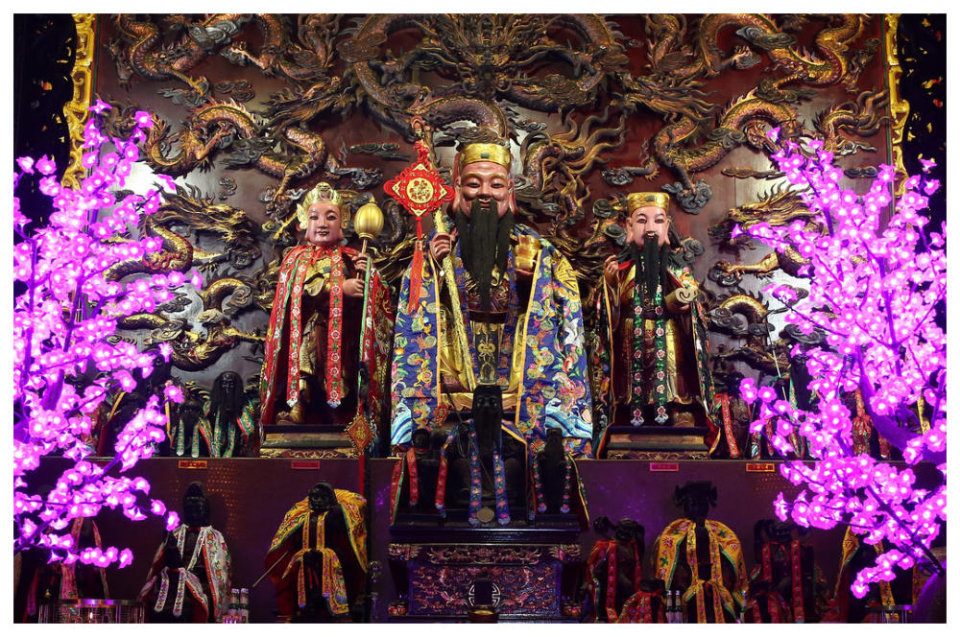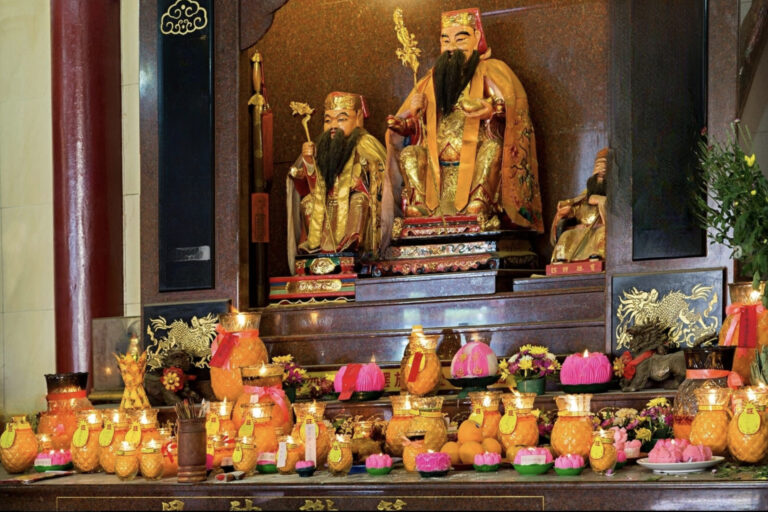In the intricate weave of Chinese folk religion and Taoism, Tua Pek Kong, also revered as the “God of Earth,” “Da Bo Gong,” or “Tua Pek Gong,” holds a position of deep respect and affection.
Originating from various legends, with one tracing his origins back to the early settlement days of the Hokkien people in Penang, Malaysia, Tua Pek Kong has become a pantheon celebrated in various forms across Southeast Asia. Synonymous with bestowing blessings of wealth, harmony, and protection, this deity embodies the hopes and prayers of many for prosperity and peace.
This article serves as a comprehensive guide, detailing the traditions, rituals, and practices central to Tua Pek Kong worship.
Table of Contents
Tua Pek Kong: The Guardian of Prosperity and Peace
As a local deity, Tua Pek Kong functions primarily as a spiritual guardian, offering wealth, safety, and harmony to those who pay homage.
Unlike the more celestial deities in Chinese folklore, Tua Pek Kong is known for his accessibility and closeness to the earthly realm.
Annual Rituals: Commencing the Worship of Tua Pek Kong
Though Tua Pek Kong can be venerated year-round, certain dates are particularly auspicious. Families generally worship on the lunar 1st and 15th, while business owners opt for the 2nd and 16th.
The “Tou Ya” festival on the second day of the second lunar month heralds a significant period, marking a communal honoring of the deity and the spiritual guardians.
Worship Essentials: Timing, Location, and Offerings
Worship rituals typically occur between 8 am and 4 pm, either at temples dedicated to Tua Pek Kong or at personal shrines. Offerings are crucial, usually involving:
- Various fruits (typically three to five types)
- Three main meats (chicken, fish, pork) for elaborate ceremonies
- Different forms of joss paper
- Additional symbolic items like gold and silver ingots for wealth
How to Pray to Tua Pek Kong: A Comprehensive Guide
This detailed guide provides step-by-step instructions on how to conduct prayers and rituals for Tua Pek Kong, the Chinese God of Wealth and Prosperity, to seek blessings and guidance.
Total time: 30 minutes
Preparation:
Start by cleaning the area where you will set up the altar. This act is meant to purify the space and remove any negative energies.
Setting up the Altar:
Arrange an image or statue of Tua Pek Kong on the altar. Surround it with offerings such as incense, candles, and fruits, along with other food items if desired.
Lighting the Incense:
Light three incense sticks. Hold them between your palms in a prayer gesture, and bow three times to show respect to Tua Pek Kong.
The Prayer:
Communicate your prayers either silently or aloud. Clearly articulate your wishes, express gratitude, or request guidance and protection.
Offering the Incense:
Place the incense sticks into the holder or burner at the front of the altar, ensuring they are securely positioned and can burn safely.
Using Divination Blocks:
If you seek specific guidance or approval from Tua Pek Kong, use the Jiaobei blocks. Ask your question and drop the blocks — the position they land in is interpreted as Tua Pek Kong’s response.
Burning Joss Paper:
As a concluding ritual, burn joss paper in a safe container. This act is an offering to Tua Pek Kong and other spirits, symbolizing sending material goods to the spiritual realm.
Concluding the Prayer:
Finish your prayer session by bowing three times to show respect. Afterwards, dispose of the offerings in a respectful manner, following local customs or traditions.
How to Obtain a Tua Pek Kong Lucky Number
Many believers seek Tua Pek Kong’s guidance in revealing lucky numbers, often for decisions related to finance, business, or personal matters.
This is usually sought through prayer and the use of divination methods such as Kau Cim (fortune sticks), where the faithful ask for a number and receive it through the random selection of a numbered stick.
The interpretation often requires a knowledgeable person or priest, as it may come in the form of riddles or sayings.
Respect and Taboos in Tua Pek Kong Worship
Worshiping Tua Pek Kong, like many religious practices, involves specific rituals and observances to maintain the deity’s respect and favor. Whether you’re a devotee or a visitor wishing to pay homage, being aware of these customs and prohibitions is essential.
- Appropriate Attire: When visiting a Tua Pek Kong temple, dressing modestly is a sign of respect. Avoid overly casual or revealing clothing. Some temples also require visitors to remove their shoes before entering the sacred spaces.
- Mourning Periods: If a family is in mourning, it’s customary to refrain from visiting the temple until the mourning period is over, which can last from 49 days to a year, depending on the family’s traditions. This practice stems from the belief that mourning carries a yin energy, which is not conducive to the yang energy in temples.
- Optimal Praying Time: The best time for worship is often considered to be in the morning, from 5 AM to 7 AM, a period called “Zi Shi” (子时). This timeframe is believed to be auspicious and when Tua Pek Kong grants blessings. However, prayers can generally be conducted from 7 AM to 5 PM, depending on the temple’s open hours.
- Pregnant Women and New Mothers: Traditionally, pregnant women and mothers who have recently given birth are discouraged from visiting temples due to the belief in ‘dirty qi’ (negative energy) associated with childbirth. They are advised to wait for at least a month after childbirth before visiting a temple.
- Sincerity in Prayers: When praying to Tua Pek Kong, sincerity is more valued than the extravagance of the offerings. Devotees believe that honest and heartfelt prayers are more likely to receive the deity’s blessings and protection.
- Offerings Protocol: Traditional offerings include incense, candles, flowers, fresh fruits, and food items such as roasted pork or duck. However, it’s essential to note that the offerings should always be in even numbers, as odd numbers are traditionally associated with funerals and thus considered inauspicious.
- Incense Etiquette: When lighting incense, it’s customary to light three sticks, sometimes accompanied by a prayer or mantra. Once lit, the incense should be placed in the designated burner or pot; avoid blowing out the flame as it’s considered disrespectful. Instead, wave your hand gently to extinguish the flame.
- Prohibitions during Worship: There are certain taboos to note, especially during worship. For instance, pointing directly at the statues or images of the deities is considered rude. Additionally, speaking loudly or behaving raucously in the temple premises is frowned upon, as it disrupts the peaceful atmosphere essential for worship. It’s also considered disrespectful to turn one’s back to the deity; when walking away from the altar, one should move backward.
- Head Coverings: Removing hats or any head coverings before entering the temple is a sign of respect, much like removing shoes as is customary in many temples.
- Special Considerations for Women: In some traditional beliefs, women are not encouraged to enter the temple during their menstrual periods. This taboo stems from historic perceptions of purity and impurity during worship.
- Photography Rules: While taking photos for keepsake is generally acceptable, always look for signs or ask temple staff for permission before taking photographs, especially of the altar or the deities, to avoid showing disrespect.
- Observance of Festivals: Participating in festivals related to Tua Pek Kong, such as his birthday celebrations, involves following specific rituals. These might include processions, vegetarian fasts, or even opera performances within the temple grounds. It’s crucial to observe and respect these traditions, even if you’re there as an observer.
Understanding and adhering to these practices and taboos not only shows reverence to Tua Pek Kong but also enriches one’s cultural experience.
Whether you’re seeking blessings, protection, or simply wishing to pay your respects, honoring these traditions will ensure a respectful and fulfilling visit to Tua Pek Kong’s temple.
Popular Tua Pek Kong Temples in Southeast Asia

- Singapore:
- Loyang Tua Pek Kong Temple: This temple stands as a unique multi-religious space, hosting various Chinese deities, along with Hindu gods. It’s especially vibrant during its annual Tua Pek Kong festival, attracting devotees with its grand rituals and various cultural performances.
- Address: 20 Loyang Way, Singapore 508774.
- Tua Pek Kong Temple, Tanjong Pagar: One of the oldest temples dedicated to Tua Pek Kong in Singapore. This temple is a hotspot during the annual Hungry Ghost Festival, known for its historical significance and captivating traditional architecture.
- Address: 158 Telok Ayer Street, Singapore 068613.
- Hai Inn Temple: This temple is famed for its colorful architecture and statues. It plays a central role during festivals, particularly Chinese New Year, when the temple comes alive with devotees seeking blessings for the year ahead.
- Address: 2 Lorong 6 Toa Payoh, Singapore 319376.
- Loyang Tua Pek Kong Temple: This temple stands as a unique multi-religious space, hosting various Chinese deities, along with Hindu gods. It’s especially vibrant during its annual Tua Pek Kong festival, attracting devotees with its grand rituals and various cultural performances.
- Malaysia:
- Sibu Tua Pek Kong Temple: Positioned at the confluence of the Rajang and Igan Rivers in Sarawak, this temple is a sight to behold during Tua Pek Kong’s birthday and Chinese New Year, known for its elaborate festivities and intricate design.
- Address: Temple Street, 96000 Sibu, Sarawak.
- Hock Teck See Temple, Penang: Also known as the Tua Pek Kong temple, it is one of the oldest Taoist temples in Penang. The temple is renowned for its stunning architecture and the grandeur of its religious celebrations.
- Address: Jalan C.Y. Choy, George Town, 10300 George Town, Pulau Pinang.
- Kuan Yin Teng, Penang: While it’s commonly known as the Goddess of Mercy Temple and primarily dedicated to Guan Yin, this temple, established in 1728, is also home to Tua Pek Kong, Guan Yu, and other deities, reflecting the diverse Chinese community in George Town. Originally built by the seafaring Hokkiens and dedicated to Mazu, the sea goddess, the temple underwent renovations in 1800, and the main deity was changed to Guan Yin. Despite the name, devotees also come to worship Tua Pek Kong, contributing to the temple’s status as one of the oldest and most significant in Malaysia. Its ancient architecture and serene atmosphere offer a unique spiritual experience.
- Address: Jalan Masjid Kapitan Keling, George Town, 10200 George Town, Pulau Pinang.
- Sibu Tua Pek Kong Temple: Positioned at the confluence of the Rajang and Igan Rivers in Sarawak, this temple is a sight to behold during Tua Pek Kong’s birthday and Chinese New Year, known for its elaborate festivities and intricate design.
These temples serve not only as places of worship but also as community centers where traditions are preserved, and cultural festivities are celebrated.
Each has its own unique history and significance in the local community, making them important cultural landmarks in Southeast Asia.
Whether you’re a devotee or a visitor interested in the rich cultural tapestry of the region, these temples offer a profound glimpse into the spiritual life and communal traditions tied to Tua Pek Kong worship.
The Power of the Tua Pek Kong Mantra
In the relentless pursuit of wealth that characterizes modern society, many overlook a fundamental principle: wealth comes to those who have accumulated sufficient merit and blessings. One way to cultivate this spiritual wealth is through the diligent recitation of the Tua Pek Kong Mantra, also known as the Earth God Mantra or “安土地真言” in Chinese.
This potent mantra goes as follows:
Namo sam-man-do, moo-toh-nam, om, doo-loo doo-loo dei-wei, so-ha.
Tua Pek Kong Mantra
南摩三满多 母驮喃 嗡 度噜度噜地尾 梭哈
This mantra’s appeal is its simplicity and universal accessibility. You can chant it anywhere, anytime, with limitless spiritual gains. Consistent practice, reaching at least a million recitations, can attract considerable wealth. Achieving hundreds of millions of chants is said to bring even greater prosperity.
However, it’s crucial to understand that the mantra isn’t just a chant for material wealth. It’s a spiritual practice that aligns you with the energies of gratitude, merit, and the compassionate nature of Tua Pek Kong, fostering peace and contentment in your life. This mantra’s power isn’t merely in the accumulation of physical riches but in cultivating an abundance mindset that welcomes all forms of prosperity.
Remember, everyone can integrate this mantra into their daily practices. It’s a universal chant that doesn’t discriminate but instead, blesses everyone willing to dedicate themselves to it. As you recite the Tua Pek Kong Mantra, you invite peace, stability, and an ever-flowing stream of wealth into your life, proving that prosperity is as much a state of mind as it is a state of your bank account.
Deepening Your Bond with Tua Pek Kong
Regular homage and heartfelt prayers to Tua Pek Kong can enhance personal luck and prosperity. Certain astrological aspects, like having a strong Tian Tong star or being born on specific dates, are believed to foster a closer relationship with the deity, who is regarded almost like an adoptive spiritual parent.
The Spiritual Journey of Tua Pek Kong Devotion
Worshiping Tua Pek Kong is more than a ritual; it’s a pathway to communal harmony, personal prosperity, and spiritual fulfillment.
By honoring the deity’s traditions and understanding his preferences, devotees can hope for Tua Pek Kong’s abundant blessings and protection.
What is Tua Pek Kong Worship?
Tua Pek Kong Worship involves venerating the deity Tua Pek Kong, believed to bestow prosperity, success, and peace. It includes rituals like offering prayers, incense, and joss paper, along with seasonal festivals at temples dedicated to this deity.
How do I start worshiping Tua Pek Kong?
To begin worshiping Tua Pek Kong, you can visit a local temple with his idol, bring offerings such as fruits, incense, and tea, and recite prayers or mantras dedicated to him. Alternatively, you can set up a small altar at home and follow similar practices.
What are the benefits of worshiping Tua Pek Kong?
Devotees believe Tua Pek Kong Worship attracts good fortune, wealth, health, and peace. Regular worship is thought to ward off evil spirits and bring positive energy into one’s life and business endeavors.
Are there any specific rituals for Tua Pek Kong Worship?
Yes, Tua Pek Kong Worship involves specific rituals, including presenting various offerings, lighting incense sticks, chanting mantras, and sometimes using divination blocks for guidance or permission during worship.
Can I worship Tua Pek Kong at home?
Absolutely, you can worship Tua Pek Kong at home by setting up an altar with his image or statue, incense burners, and space for offerings. Regular prayers and offerings are recommended for continuous blessings.
What offerings are suitable for Tua Pek Kong Worship?
Common offerings for Tua Pek Kong include fruits, incense, tea, and joss paper. On special occasions, devotees might offer cooked meals, sweet treats, and even monetary offerings.
Is there a special festival for Tua Pek Kong Worship?
Tua Pek Kong’s birthday, celebrated on the 2nd day of the Chinese New Year, is a significant festival. Devotees visit temples for a grand ceremony, including elaborate offerings, lion dances, and sometimes, firecracker displays.
What mantra can I chant for Tua Pek Kong Worship?
The Tua Pek Kong Mantra “Namo sam-man-do, moo-toh-nam, om, doo-loo doo-loo dei-wei, so-ha” is often chanted. It’s believed to bring wealth and prosperity, especially when recited diligently.



